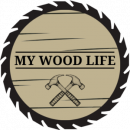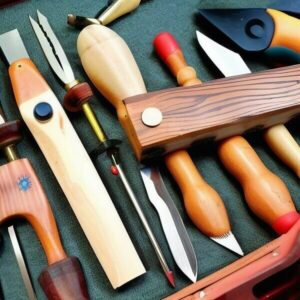When you’re just starting out in wood carving, it can be a bit intimidating to figure out which tools you need and how to use them. We’ve compiled a list of the top 10 essential wood carving tools that are perfect for beginners.
Let’s take a look at what these tools are and how they work:
10 Wood Carving Best Tools for Beginners
1. Chisels: Chisels are the most basic and versatile wood carving tools, and they come in a variety of sizes and shapes. Depending on your project, you may want to select different chisels for different tasks. To use a chisel, hold it firmly in one hand while striking it with a hammer in the other.
2. Gouges: Gouges are U-shaped carving tools that can be used to create hollows and curves in the wood. To use a gouge, hold it firmly in one hand while pressing against the wood with your other hand, using a rocking motion for curved lines.
3. V-Tools: V-tools are specially designed chisels that have a V-shaped blade. They can be used to create detailed lines and grooves in the wood, or even to carve letters. To use a V-tool, hold it firmly in one hand while striking it with a hammer in the other.
4. Carving Knives: Carving knives are small, razor-sharp blades that can be used to cut intricate details and shapes in the wood. To use a carving knife, hold it firmly in one hand while pressing on the wood with your other hand to make shallow cuts.
5. Rasps: Rasps are coarse tools that can be used to quickly shape large pieces of wood. They come in a variety of sizes, shapes, and grits. To use a rasp, hold it firmly in one hand while pressing on the wood with your other hand to shape it as desired.
6. Files: Files are similar to rasps, but they have finer teeth that can be used to create more precise shapes and details. To use a file, hold it firmly in one hand while pressing on the wood with your other hand to shape it as desired.
7. Mallets: Mallets are used to drive chisels and gouges into the wood. They come in different sizes and weights depending on the job you need to do. To use a mallet, hold the tool firmly in one hand and the mallet in the other.
8. Drawknives: Drawknives are long blades with handles on either side. They can be used to quickly shape large pieces of wood by shaving off thin slices. To use a drawknife, hold it firmly in both hands and pull it across the wood with a sawing motion.
9. Sandpaper: Sandpaper is used to smooth out rough surfaces and sharp edges. It comes in different grits, so you can choose one that’s appropriate for your project. To use sandpaper, hold it firmly in one hand while running it over the wood with your other hand.
10. Finishing Tools: Finishing tools are used to apply a protective finish to the wood. These include items like sanding blocks, buffing wheels, and texturing hammers. To use these tools, follow the instructions included with them.
Don’t Forget To Use Safety Gear!
No matter which wood carving tools you use, you should always wear safety gear such as goggles and gloves. It’s also important to keep your tools sharp and well-maintained, as dull blades can be dangerous.
It’s also important to invest in quality protective gear such as leather gloves, safety glasses or goggles, and a dust mask. This will help protect you from flying wood chips and sawdust, as well as sharp edges that could cause injury. Additionally, make sure your work area is clear of clutter, so you have plenty of room to maneuver.
Lastly, always keep your tools clean and sharpened after each use. This will help ensure you have a safe and successful wood carving experience.
What Basic Tools Do You Need For Starting Wood Carving?
Four essential tools needed for starting wood carving are chisels, gouges, V-tools, and carving knives. Chisels can be used to carve straight lines into the wood while gouges are useful for creating hollows and curves.
V-tools have a unique V-shaped blade that can be used to create detailed lines and grooves in the wood. Carving knives are small and sharp, perfect for making delicate cuts. These tools will be key to beginning your wood carving journey.
Which Wood Should I Use as a Beginner Wood Carver?
Softwoods like basswood, pine, and balsa are great options for beginner wood carvers. They are easy to shape and provide a good surface for learning the basics of carving. As you become more experienced, you can move on to harder woods such as oak or walnut for more intricate designs. Make sure you always use quality tools when you’re working with harder wood so you can avoid chipping or splitting the wood.
How Can I Practice in Wood Carving?
One of the best ways to practice wood carving is to start with a simple project. Begin by tracing or sketching out your design onto a piece of wood. Then, take your time and carefully carve the design using one of the tools mentioned above.
Practicing on scrap pieces of wood can also be helpful for getting used to how each tool works. This will help you gain confidence in the tools and your carving technique. As you become more experienced, you can move on to larger and more detailed projects.
Finally, don’t be afraid to make mistakes. Wood carving is a skill that takes time and practice so don’t get discouraged if it doesn’t come easily at first. With tenacity, practice, and commitment you will soon be creating exquisite works of art.
What Is The Basic Technique I Should Use as a Wood Carving Beginner?
The basic technique for wood carving is to use a controlled, steady pressure while cutting. Make sure you have a firm grip on the tool and cut in small increments at first until you become comfortable with how each tool works.
When carving curves, make sure to move the tool in a consistent motion and pull or push it in the same direction. Practice on scrap pieces of wood to perfect your technique before starting any projects. And most importantly, use safety gear!
Conclusion
Wood carving is a rewarding and fulfilling craft that anyone can learn with the right tools, safety gear, and practice. With patience, determination, and time you will be able to make beautiful works of art from simple pieces of wood. So don’t wait any longer – gather your tools, pick up a piece of wood, and get started!









